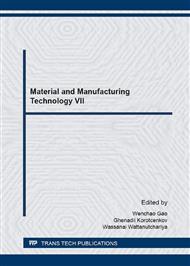[1]
O.V. Nosochenko, O.B. Isaev, L.S. Lepikhov, P.A. Degtyarev, V.P. Kharchevnikov, N.P. Mel'nik, V.M. Lyudkovskii, Reducing axial segregation in a continuous-cast semifinished product by micro-alloying, Metallurgist 47 (2003) 244-247.
DOI: 10.1023/a:1025685015163
Google Scholar
[2]
O.B. Isaev, Effectiveness of using large cooling elements to alleviate axial segregation in continuous-cast ingots, Metallurgist 49 (2005) 324-331.
DOI: 10.1007/s11015-005-0099-6
Google Scholar
[3]
S. Zhao, L. Zhang, Effect of steel strip-feeding process on solidification structure, Adv. Mater. Res. 941-944 (2014) 1744-1747.
DOI: 10.4028/www.scientific.net/amr.941-944.1744
Google Scholar
[4]
L.H. Yu, Z.S. Zhang, A. Shevchenko, M.G. Shen, Y.Y. Wang, Effects of continuous casting billet quality with steel strip's feeding into continuous casting crystallizer, Iron and Steel 50 (2015) 53-56 (in Chinese).
Google Scholar
[5]
W.B. Li, F. Wang, F.S. Qi, B.K. Li, Mathematical model on steel strip-feeding of mold in continuous casting process, Acta Metall. Sin. 43 (2007) 1191-1194 (in Chinese).
Google Scholar
[6]
H. Wang, Original position statistic distribution analysis (OPA)- Novel statistic characterization method of different chemical compositions and its states of the materials, Mater. Sci. Forum 539-543 (2007) 4446-4451.
DOI: 10.4028/www.scientific.net/msf.539-543.4446
Google Scholar
[7]
D. Li, H. Wang, Original position statistic distribution analysis for the sulfides in gear steels, ISIJ Int. 54 (2014) 160-164.
DOI: 10.2355/isijinternational.54.160
Google Scholar
[8]
J. Hu, M. Han, L. Yuan, H. Wang, Original position statistic distribution analysis of trace element segregation in nickel-base super alloy by LA-ICP-MS, ISIJ Int. 52 (2012) 2055-(2058).
DOI: 10.2355/isijinternational.52.2055
Google Scholar
[9]
X.H. Li, Y.L. Kang, G.L. Wu, A.D. Xiao, Original position statistic distribution analysis for thin slab produced by CSP, J. Iron Steel Res. 21 (2009) 9-12 (in Chinese).
Google Scholar
[10]
D. Li, H. Wang, Determination of inclusions of boron and titanium in steel by original position statistic distribution analysis technique, Mater. Sci. Forum 539-543 (2007) 4272-4276.
DOI: 10.4028/www.scientific.net/msf.539-543.4272
Google Scholar


